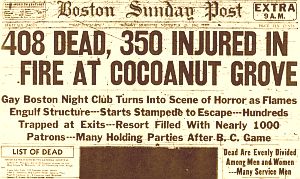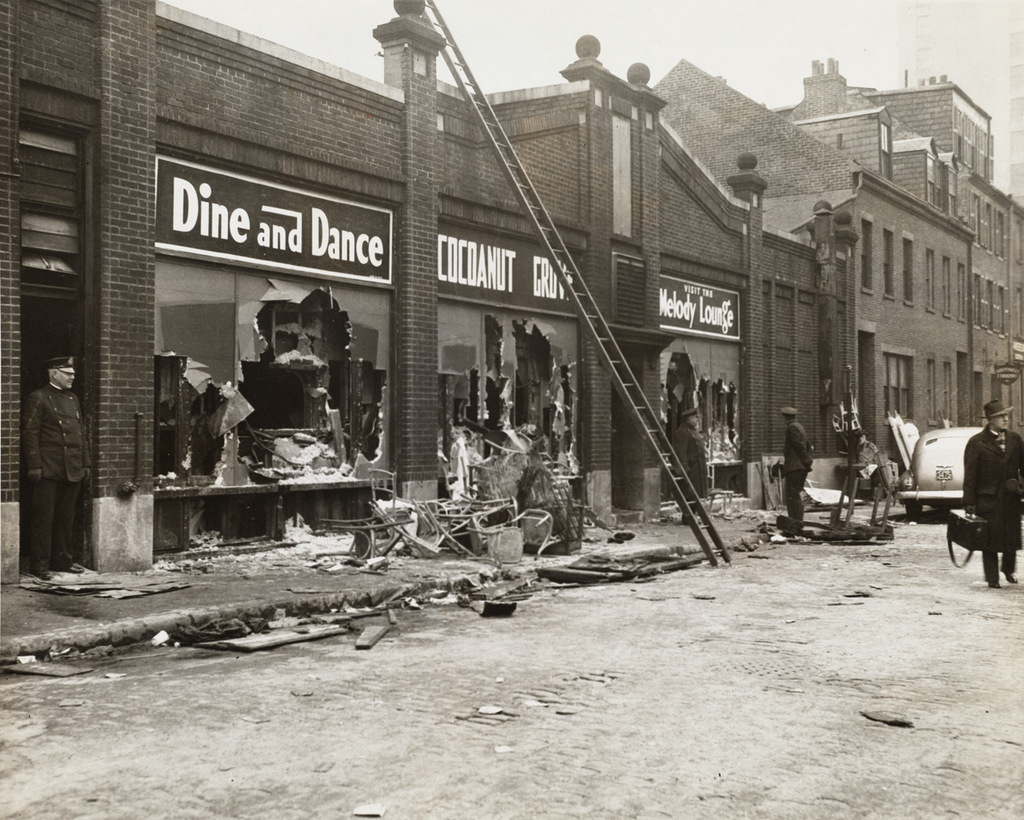General Discussion
Related: Editorials & Other Articles, Issue Forums, Alliance Forums, Region Forums75 Years Ago Today: Cocoanut Grove Nightclub Fire in Boston Kills 492

The fire
Official reports state that the fire started at about 10:15 pm in the dark, intimate Melody Lounge downstairs. Goody Goodelle, a young pianist and singer, was performing on a revolving stage, surrounded by artificial palm trees. The lounge was lit by low-powered light bulbs in coconut-styled sconces beneath the fronds. A young man, possibly a soldier, had unscrewed a light bulb in order to give himself privacy while kissing his date.[4] Stanley Tomaszewski—a 16-year-old busboy—was instructed to put the light back on by tightening the bulb. He stepped up onto a chair to reach the light in the darkened corner. Unable to see the bulb, he lit a match to illuminate the area, tightened the bulb, and extinguished the match. Witnesses first saw flames in the fronds, which were just below the ceiling, immediately afterward. Though the lit match had been close to the same fronds where the fire was seen to have begun, the official report determined that Tomaszewski's actions could not be found to be the source of the fire, which "will be entered into the records of this department as being of unknown origin".
Despite waiters' efforts to douse the fire with water, it spread along the fronds of the palm tree. In a final desperate attempt to separate the burning fronds from the fabric-covered false ceiling the decoration was pulled away from the corner, taking with it a triangular plywood panel at the ceiling level and opening the enclosed space above the false ceiling. Coincidentally or not, that was the point at which the fire spread to the false ceiling which burned rapidly, showering patrons with sparks and burning shreds of fabric. Flames raced up the stairway to the main level, burning the hair of patrons fleeing up the stairs. A fireball burst through the front entryway and spread through the remaining club areas: through the adjacent Caricature Bar, down a corridor to the Broadway Lounge, and across the central restaurant and dance floor as the orchestra was beginning its evening show. Flames raced faster than patrons could move, followed by thick clouds of smoke. Within five minutes, flames and smoke had spread to the entire nightclub. Some patrons were instantly overcome by smoke as they sat in their seats. Others crawled through the smoky darkness trying to find exits, all but one of which were either non-functioning or hidden in non-public areas.
Many patrons attempted to exit through the main entrance, the same way they had entered. The building's main entrance was a single revolving door, which was rendered useless as the crowd stampeded in panic. Bodies piled up behind both sides of the revolving door, jamming it until it broke.
But then the oxygen-hungry fire leaped through the breach, incinerating whoever was left alive in the pile. Firemen had to douse the flames to approach the door. Later, after fire laws had tightened, it would become illegal to have only one revolving door as a main entrance without being flanked by outward opening doors with panic bar openers attached, or have the revolving doors set up so that the doors could fold against themselves in emergency situations.
Other avenues of escape were similarly useless; side doors had been bolted shut to prevent people from leaving without paying. A plate glass window, which could have been smashed for escape, was boarded up and unusable as an emergency exit. Other unlocked doors, like the ones in the Broadway Lounge, opened inwards, rendering them useless against the crush of people trying to escape. Fire officials would later testify that had the doors swung outwards, at least 300 lives could have been spared.
From nearby bars, soldiers and sailors raced to assist. On the street, firefighters lugged out bodies and were treated for burned hands. As night deepened, the temperature dropped. Water on cobblestone pavements froze. Hoses froze to the ground. Newspaper trucks were appropriated as ambulances. Smoldering bodies, living and dead, were hosed in icy water. Some victims had breathed fumes so hot that when they inhaled cold air, as one firefighter put it, they dropped like stones.
Later, during the cleanup of the building, firefighters found several dead guests sitting in their seats with drinks in their hands. They had been overcome so quickly by fire and toxic smoke that they had not had time to move.
</snip>
Achilleaze
(15,543 posts)and live to tell the blazing, insane story of it all. When he eventually did die years later, it was, ironically, smoke and fire that brought him down: cigarettes.

Docreed2003
(16,876 posts)Yet, much like many tragedies of the past, good actually did come out of the fire. The treatment of burns was revolutioned with this event, to the point that lessons learned would be carried on to the battlefields of WWII and critical care centers across the world.
The event would spur on the study of the body’s electrolyte composition. Francis Moore, a young surgeon who participated in the care of many of the victims, would go on to write the definitive book on electrolytes, driven in large part to his experiences in the aftermath of the fire. His research was groundbreaking at the time and is still quoted in surgical textbooks today in the management of fluids in the post surgical and critical care patient. Moore would become the chair of Surgery at the Brigham Hospital and his leadership would be credited by Dr Joseph Murray when he accepted the Nobel Prize for the first kidney transplantation.
Thank you for sharing this story of horrific tragedy, many haven’t ever heard of this event.
FailureToCommunicate
(14,022 posts)Mom was working for the Red Cross in Boston helping with the war effort in 1942. Many of the nearly 500 patrons killed and injured were servicemen, and the despirate needs of the hundreds of injured and their families continued for many months after the fire. That was what my mother -with the Red Cross- was assisting. Though it was hard for her to talk about even years later, her stories of the anguished survivors were vivid reminders to us kids to always pay attention to your surroundings, AND of the evil consequences of greed (the locked doors).
On the positive side, countless lives since that fire have been saved from fire safety regulations enacted in the aftermath. Occupancy limits, clearly marked exit signs, fire retardant decorations, sufficent outward opening exit doors, especially flanking revolving doors. As a tie in with the aftermath of the Halifax explosion back in 1917, Boston had become an innovative center for treatment of burn victims.

This Globe article mentions a new film about the catastrophe. The article does not cover the hundreds injured, nor the real cause of the loss of life: the locked doors (so patrons wouldn't skip out on paying), the inward opening doors, the only main exit was a revolving door, the overcrowding (500 over the limit) etc. Nor does it mention all the good fire safety laws that eventually came about as a result of Coconut Grove.
https://www.bostonglobe.com/metro/2017/11/25/event-mark-anniversary-cocoanut-grove-nightclub-fire/tbgPFa7yZGkUuuZxOlyuxO/story.html

Kingofalldems
(38,484 posts)msongs
(67,441 posts)FailureToCommunicate
(14,022 posts)FailureToCommunicate
(14,022 posts)A memorial is (finally) being placed in Statler Park, nearby the original location of the nightclub:
https://www.boston.com/news/local-news/2023/11/27/boston-memorial-deadly-fire-cocoanut-grove-nightclub/